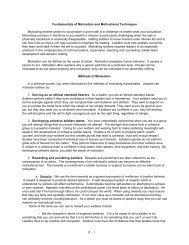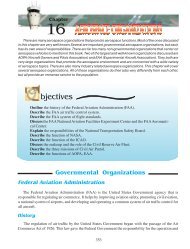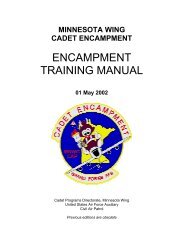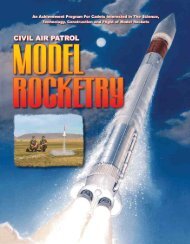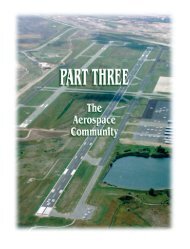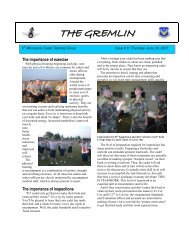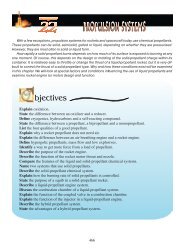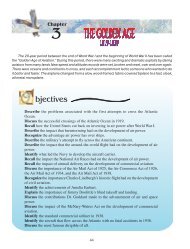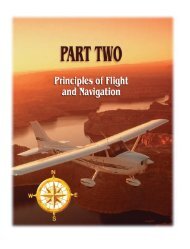12.1 Strategic Leadership: Defining the ChallengeBy Col W. Michael Guillot, USAFOBJECTIVES:1. Define the term “strategic leadership.”2. Identify the four components of the strategic leadership environment, and list factors that belongto each component.3. Describe four characteristics of consequential decisions.4. List and define four challenges of strategic leadership.5. Recall competencies that are essential for leaders who wish to develop strategic leadership skills.The only thing harder than being a strategic leader istrying to define the entire scope of strategic leadership—a broad, difficult concept. We cannot always define it ordescribe it in every detail, but we recognize it in action.This type of leadership involves microscopic perceptionsand macroscopic expectations. Volumes have been writtenon the subject, which may in fact contribute to the difficultyof grasping the concept. One finds confusing andsometimes conflicting information on this blended conceptthat involves the vagaries of strategy and the behavioralart of leadership. Sometimes the methods and modelsused to explain it are more complicated than the conceptand practice of strategic leadership itself. Exercising thiskind of leadership is complicated, but understanding itdoesn’t have to be. Beginning with a definition and characterizationof strategic leadership and then exploringcomponents of the strategic environment may provehelpful. Future leaders must also recognize the nature ofthat environment. Finally, they should also have somefamiliarity with ways of developing competencies fordealing with the broad, new challenges that are part ofleading in the strategic environment.WHAT IS STRATEGIC <strong>LEAD</strong>ERSHIP?The common usage of the term strategic is related to theconcept of strategy—simply a plan of action for accomplishinga goal. One finds both broad and narrow sensesof the adjective strategic. Narrowly, the term denotesoperating directly against military or industrial installationsof an enemy during the conduct of war with the intentof destroying his military potential. 1 Today, strategicis used more often in its broader sense (e.g., strategicplanning, decisions, bombing, and even leadership). Thus,we use it to relate something’s primary importance or itsquintessential aspect—for instance, the most advantageous,complex, difficult, or potentially damaging challenge to anation, organization, culture, people, place, or object.When we recognize and use strategic in this broad sense,we append such meanings as the most important longrangeplanning, the most complex and profound decisions,and the most advantageous effects from a bombing campaign—aswell as leaders with the highest conceptualability to make decisions.As mentioned earlier, strategy is a plan whose aim is tolink ends, ways, and means. The difficult part involves thethinking required to develop the plan based on uncertain,ambiguous, complex, or volatile knowledge, information,and data. Strategic leadership entails making decisionsacross different cultures, agencies, agendas, personalities,and desires. It requires the devising of plans that are feasible,desirable, and acceptable to one’s organization andpartners—whether joint, interagency, or multinational.Strategic leadership demands the ability to make sound,reasoned decisions—specifically, consequential decisionswith grave implications. Since the aim of strategy is tolink ends, ways, and means, the aim of strategic leadershipis to determine the ends, choose the best ways, andapply the most effective means. The strategy is the plan;strategic leadership is the thinking and decision makingrequired to develop and effect the plan. Skills for leadingat the strategic level are more complex than those forleading at the tactical and operational levels, with skillsblurring at the seams between those levels. In short, onemay define strategic leadership as the ability of an experienced,senior leader who has the wisdom and vision to createand execute plans and make consequential decisions in thevolatile, uncertain, complex, and ambiguous strategic environment.COMPONENTS OF THE STRATEGICENVIRONMENTWhat is the strategic-leadership environment? One constructincludes four distinct, interrelated parts: the nationalsecurity, domestic, military, and internationalenvironments (fig. 1). Within the strategic environment,strategic leaders must consider many factors and actors.This construct is neither a template nor checklist—nor a10
ecipe for perfection. The framework recognizes the factthat strategic leaders must conceptualize in both the politicaland military realms. Additionally, it illustrates howthe strategic environment is interrelated, complementary,and contradictory. Leaders who make strategic decisionscannot separate the components, especially when theyare dealing with the national security environment.Strategic leaders must recognize and understand thecomponents of the national security environment. Theultimate objectives of all US government personnel arethose presented in the national security strategy. Thestrategy and its objectives shape the decision making ofstrategic leaders, who must understand the nationalinstruments of power—political, economic, and military.These instruments provide the means of influence—forexample, political persuasion (diplomacy), economicmuscle (aid or embargo), or military force (actual orthreatened). Within the national security environment,strategic leaders should consider national priorities andopportunities and must know the threats and risks tonational security, as well as any underlying assumptions.Understanding this environment poses a major undertakingfor strategic leaders. It is also the foundation forunderstanding the military environment.Personnel who aspire to be strategic leaders, especiallywithin the Department of Defense, must thoroughlyunderstand military strategy. Two reasons come to mind.First, because the military instrument of power has suchgreat potential for permanent change in the strategicenvironment, all strategic leaders must recognize its risksand limitations. Second, because military experienceamong civilian leaders has dwindled over the years andwill continue to do so, strategic leaders have a greaterresponsibility to comprehend policy guidance and clearlyFigure 1understand expected results. Only then can they effectivelyset military objectives and assess the risks of militaryoperations. Such leaders must develop and evaluatestrategic concepts within the military environment andrecognize potential threats. Finally, strategic leaders willhave to balance capabilities (means) against vulnerabilitiesand, in doing so, remain aware of the domestic coalitionas a major influence.Since the founding of our nation—indeed, even before thesigning of the Constitution—the domestic environmenthas influenced our leaders. Over the last 200 years, littlehas changed in this regard; in fact, most people wouldargue that domestic influence has increased. For instance,strategic leaders today must pay particular attention tothe views, positions, and decisions of Congress, whosepower and influence pervade many areas within thestrategic environment—both foreign and domestic. Congresshas the responsibility to provide resources, and we havethe responsibility to use them prudently and account forthem. This partnership encompasses national and localpolitics, budget battles for scarce dollars, and cost-risktrade-offs. Strategic leaders cannot ignore either thecongressional part of the domestic environment—eventhough the relationship can sometimes prove difficult—orsupport from the population. Such support is extremelyrelevant in democracies and certainly so in the UnitedStates. The problem for the strategic leader lies in accuratelymeasuring public support. Accurate or not, seniorleaders in a democracy ignore public support at theirperil. Actually, because of their power and influence,components of the media make it impossible to ignoredomestic issues. Strategic leaders must know how toengage the media since the latter can help shape thestrategic environment and help build domestic support.Finally, even though the political will may change, environmentalactivism will continue to affect the decisionsof strategic leaders at every level. Environmentaldegradation remains a concern for strategic leadersin this country, as do problems in the internationalenvironment that call for strategic decisions.When considering the international environment,strategic leaders should first explore thecontext—specifically, the history, culture, religion,geography, politics, and foreign security.Who are our allies? Do we have any alliances inplace, or do we need to build a coalition? Whatresources are involved— physical or monetary? Isdemocracy at stake— creating or defending it?Leaders should also consider threats to the balanceof power (BOP) in the environment and theinvolvement of both official and unofficial organizations.The United Nations may already have11
- Page 1 and 2: VOLUME FOUR STRATEGIC PERSPECTIVESL
- Page 3 and 4: VOLUME FOUR STRATEGIC PERSPECTIVESL
- Page 5 and 6: VOLUME FOUR STRATEGIC PERSPECTIVESL
- Page 7: VOLUME FOUR STRATEGIC PERSPECTIVESL
- Page 10 and 11: 12CHAPTER 12INTRODUCTION TO STRATEG
- Page 14 and 15: mandates or resolutions that would
- Page 16 and 17: and ambiguity, aspiring strategic l
- Page 18 and 19: 12.2 National Security StrategyThe
- Page 20 and 21: within our borders has always been
- Page 22 and 23: front common challenges like violen
- Page 24 and 25: and our strategy, not sector earmar
- Page 26 and 27: thinking about organizations. She m
- Page 28 and 29: A systemic approach to failure is m
- Page 30 and 31: The late W. T. Grant Company is a r
- Page 32 and 33: the resources - setting the directi
- Page 34 and 35: focal point for describing and inte
- Page 36 and 37: Consequently, we do not restrict th
- Page 38 and 39: paragraphs, Web pages, then edit an
- Page 40 and 41: Web, can be viewed as a CS attempt
- Page 42 and 43: How to evaluate users and contribut
- Page 44 and 45: 13CHAPTER 13LEADING PUBLIC &VOLUNTE
- Page 46 and 47: 13.1 Leadership for Volunteers:The
- Page 48 and 49: 13.2 Take Root: Volunteer Managemen
- Page 50 and 51: QualificationsClearly list educatio
- Page 52 and 53: and effectively track their volunte
- Page 54 and 55: • Understand rules for recognitio
- Page 56 and 57: • Send a birthday card.• Submit
- Page 58 and 59: and tested more than six decades af
- Page 60 and 61: specific interests of the donors, v
- Page 62 and 63:
tain) tax-exempt status from the In
- Page 64 and 65:
Smucker, 1999).The Internal Revenue
- Page 66 and 67:
culture is necessary to ensure the
- Page 68 and 69:
13.4 The New Look of TransparencyBy
- Page 70 and 71:
ees for a couple of reasons: One, i
- Page 72 and 73:
13.5 Public and Private Management:
- Page 74 and 75:
TABLE 1:FUNCTIONS OF GENERAL MANAGE
- Page 76 and 77:
3. Career System. The model corpora
- Page 78 and 79:
islative charter - the Clean Air Ac
- Page 80 and 81:
In controlling performance, Chapin
- Page 82 and 83:
14CHAPTER 14AIRPOWER ASSTRATEGIC LA
- Page 84 and 85:
14.1 Strategic Air Power: Fulfillme
- Page 86 and 87:
carry it out. Their daylight raids
- Page 88 and 89:
you did not rely on strategic bombi
- Page 90 and 91:
14.2 Warden and the Air Corps Tacti
- Page 92 and 93:
ecomes one of applying sufficient i
- Page 94 and 95:
tification, and a Jominian claim to
- Page 96 and 97:
courage the rapid and widespread ex
- Page 98 and 99:
it to influence physical players in
- Page 100 and 101:
14.4 Basic Air Force DoctrineAF Doc
- Page 102 and 103:
earthquake-stricken Haiti. The worl
- Page 104 and 105:
perspective. Airmen do not divide u
- Page 106 and 107:
Command and ControlCommand and cont
- Page 108 and 109:
14.5 Should the US Maintain the Nuc
- Page 110 and 111:
form of human government.” 20 Dem
- Page 112 and 113:
obtainable goal. See the Global Zer
- Page 114 and 115:
15CHAPTER 15ORGANIZATIONAL CULTURE
- Page 116 and 117:
15.1 Organizational CultureBy Doria
- Page 118 and 119:
Review. This action strives to unco
- Page 120 and 121:
gram will serve and then having the
- Page 122 and 123:
ticipating the changes being made b
- Page 124 and 125:
Many years of working with change p
- Page 126 and 127:
At the least, the areas of concern
- Page 128 and 129:
15.4 Developing an Innovative Cultu
- Page 130 and 131:
CONCLUDING THOUGHTSIn an ever-chang
- Page 132 and 133:
global issues. Businesses that poss
- Page 134 and 135:
— Sees the big picture—the shif
- Page 136 and 137:
16CHAPTER 16STRATEGIC COMMUNICATION
- Page 138 and 139:
16.1 Principles of Strategic Commun
- Page 140 and 141:
16.2 The Art of NegotiationBy Brend
- Page 142 and 143:
16.3 Negotiating Effectively Across
- Page 144 and 145:
hidden areas can act as cultural ho
- Page 146 and 147:
and four conflict styles. Hammer be
- Page 148 and 149:
maintaining the relationship. As th
- Page 150 and 151:
25 Mitchell R. Hammer, “Chapter 1
- Page 152 and 153:
tural, socioeconomic, and psycholog
- Page 154 and 155:
for the win-win," during which time
- Page 156 and 157:
interests and, at worst, as a gun s
- Page 158 and 159:
Public diplomacy is surely about mu
- Page 160 and 161:
But public diplomats do not have th
- Page 162 and 163:
Photo courtesy of the familyThe LEA
- Page 164:
THE CADET OATHI pledge that I will



